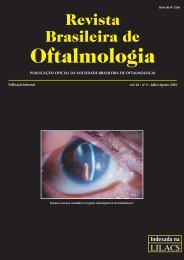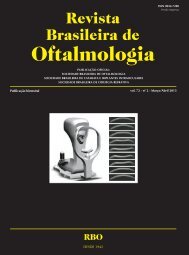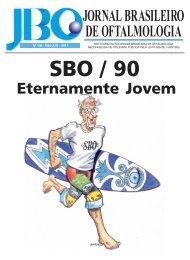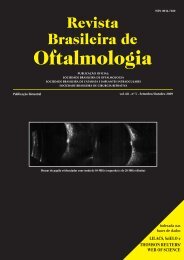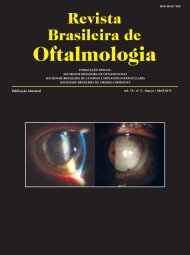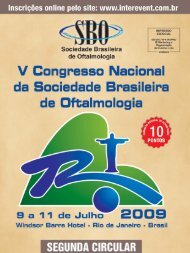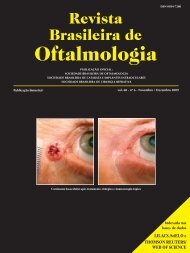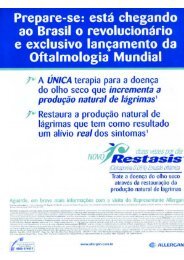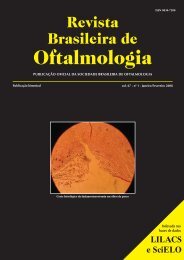to download PDF in portuguese - Sociedade Brasileira de ...
to download PDF in portuguese - Sociedade Brasileira de ...
to download PDF in portuguese - Sociedade Brasileira de ...
Create successful ePaper yourself
Turn your PDF publications into a flip-book with our unique Google optimized e-Paper software.
Use of <strong>in</strong>travitreal bevacizumab or triamc<strong>in</strong>olone ace<strong>to</strong>ni<strong>de</strong> as a preoperative adjunct <strong>to</strong> vitrec<strong>to</strong>my for vitreous haemorrhage <strong>in</strong> diabetics<br />
13<br />
RESUMO<br />
Objetivo: Avaliar o efei<strong>to</strong> no pré-operatório da <strong>in</strong>jecao <strong>in</strong>travítrea <strong>de</strong> bevacizumab (IVB) ou trianc<strong>in</strong>olona (IVT) sobre a taxa <strong>de</strong><br />
hemorragia precoce pos-vitrec<strong>to</strong>mia na ret<strong>in</strong>opatia diabética proliferativa. Mé<strong>to</strong>dos: Os olhos foram distribuídos em três grupos: IVB<br />
- 1,25 mg bevacizumab, IVT - 4,0 mg <strong>de</strong> trianc<strong>in</strong>olona e o grupo controle - simulação da <strong>in</strong>jeção. O objetivo primário foi a avaliação da<br />
<strong>in</strong>cidência da hemorragia precoce pós-vitrec<strong>to</strong>mia. Os objetivos secundários <strong>in</strong>cluíram mudanças na acuida<strong>de</strong> visual corrigida e even<strong>to</strong>s<br />
adversos relacionados à <strong>in</strong>jeção. Resultados: Dos V<strong>in</strong>te e sete olhos, 9 foram randomizados em cada grupo. A <strong>in</strong>cidência <strong>de</strong> hemorragia<br />
vítrea foi menor no grupo IVB (P=0,18). A hemorragia vítrea em 1 mês também foi menor no grupo IVB (P ≥ 0,05). A taxa <strong>de</strong><br />
sangramen<strong>to</strong> pós-operatório imedia<strong>to</strong> foi maior no grupo IVT com 4 (44,4%) dos casos. A média da acuida<strong>de</strong> visual (AV) foi <strong>de</strong> 1,72<br />
± 0,37 logMAR no pré-operatório e 1,32 ± 0,73 logMAR em 6 meses após a cirurgia. Analisando a AV por grupo evi<strong>de</strong>nciamos que o<br />
grupo IVB t<strong>in</strong>ha <strong>in</strong>icialmente AV média logMAR <strong>de</strong> 1,87 e AV logMAR <strong>de</strong> 1,57 em seis meses (p = 0,84). No grupo IVT, a média <strong>in</strong>icial<br />
<strong>de</strong> AV foi <strong>de</strong> 1,75 logMAR e 0,96 logMAR em seis meses (p ≤ 0,001). E no grupo controle, a média <strong>in</strong>icial foi <strong>de</strong> 1,85 logMAR e 1,57<br />
logMAR no seis meses (p = 0,34). Conclusão: A <strong>in</strong>jeção <strong>in</strong>travítrea <strong>de</strong> bevacizumab antes da vitrec<strong>to</strong>mia parece dim<strong>in</strong>uir a <strong>in</strong>cidência <strong>de</strong><br />
hemorragia vítrea precoce pós-vitrec<strong>to</strong>mia em diabéticos. Houve um melhor resultado na acuida<strong>de</strong> visual no grupo da trianc<strong>in</strong>olona.<br />
Descri<strong>to</strong>res: Ret<strong>in</strong>opatia diabética/cirurgia; Vitrec<strong>to</strong>mia; Inibidores da angiogênese/uso terapêutico; Bevacizumabe; Trianc<strong>in</strong>olona;<br />
Acuida<strong>de</strong> visual<br />
INTRODUCTION<br />
In spite of all the scientific advances <strong>in</strong> medic<strong>in</strong>e and <strong>in</strong> our<br />
knowledge of the pathophysiology and treatment of diabetes<br />
over the past 25 years, diabetic ret<strong>in</strong>opathy rema<strong>in</strong>s one<br />
of the lead<strong>in</strong>g causes of bl<strong>in</strong>dness <strong>in</strong> <strong>in</strong>dividuals between 20 <strong>to</strong><br />
64 years-old <strong>in</strong> <strong>in</strong>dustrialized countries (1,2) .<br />
Proliferative diabetic ret<strong>in</strong>opathy (PDR) is a major cause<br />
of visual loss <strong>in</strong> diabetic patients. In PDR, the growth of new<br />
vessels from the ret<strong>in</strong>a or optic nerve, is thought <strong>to</strong> occur as a<br />
result of vascular endothelial grow fac<strong>to</strong>r (VEGF) released <strong>in</strong><strong>to</strong><br />
the vitreous cavity as a response <strong>to</strong> ischaemia (3-5) . Early<br />
postvitrec<strong>to</strong>my hemorrhage <strong>in</strong> diabetic patients is a major<br />
concern for both surgeons and patients. On the patient’s si<strong>de</strong>,<br />
expectations regard<strong>in</strong>g visual improvement are not met, and this<br />
may be crucial <strong>in</strong> monocular patients. On the surgeon’s si<strong>de</strong>, this<br />
complication <strong>in</strong>terferes with fundus exam<strong>in</strong>ation, <strong>de</strong>tection of<br />
iatrogenic ret<strong>in</strong>al breaks, and perform<strong>in</strong>g laser therapy.<br />
Because VEGF has been shown <strong>to</strong> play a major role <strong>in</strong><br />
ret<strong>in</strong>al neovascularization (3,4) , <strong>in</strong> conjunction with other fac<strong>to</strong>rs (6,7)<br />
anti-VEGF treatments have been hypothesized as an alternative<br />
adjunctive treatment for ret<strong>in</strong>al neovascularization (8,9) .<br />
To date, pars plana vitrec<strong>to</strong>my (PPV) is the treatment of<br />
choice for PDR with vitreous hemorrhage and ret<strong>in</strong>al <strong>de</strong>tachment.<br />
There is a high risk of complication due <strong>to</strong> the bleed<strong>in</strong>g from<br />
fibrovascular membrane (10) .<br />
Oral, <strong>to</strong>pical and periocular steroids have been wi<strong>de</strong>ly used<br />
<strong>in</strong> the past <strong>in</strong> many pathologic ocular conditions that have an<br />
un<strong>de</strong>rly<strong>in</strong>g <strong>in</strong>flamma<strong>to</strong>ry basis. The ret<strong>in</strong>al neovascular<br />
proliferation <strong>in</strong> PDR often has an accompany<strong>in</strong>g <strong>in</strong>flamma<strong>to</strong>ry<br />
component. The <strong>in</strong>travitreal (IV) steroid <strong>in</strong>jections, particularly<br />
triamc<strong>in</strong>olone ace<strong>to</strong>ni<strong>de</strong>, may potentially be important <strong>in</strong> quell<strong>in</strong>g<br />
<strong>in</strong>traocular <strong>in</strong>flammation (11-13) . It is therefore <strong>in</strong>tuitive that IV<br />
steroid <strong>in</strong>jections could be beneficial <strong>to</strong> PDR.<br />
Bevacizumab (Avast<strong>in</strong> Genetech Inc.,South San Francisco,<br />
California, USA) is a humanized anti-vascular endothelial growth<br />
fac<strong>to</strong>r (VEGF) antibody used for metastatic colorectal cancer.<br />
Recent reports have <strong>de</strong>scribed the application of bevacizumab <strong>to</strong><br />
treat ocular neovascular disor<strong>de</strong>rs <strong>in</strong>clud<strong>in</strong>g PDR (14-15) . Adjunctive<br />
use of <strong>in</strong>travitreal bevacizumab for severe PDR before vitrec<strong>to</strong>my<br />
has also been reported. However, the preferable tim<strong>in</strong>g from the<br />
<strong>in</strong>jection <strong>to</strong> surgery has not been <strong>de</strong>term<strong>in</strong>ed yet (16-18) .<br />
The purpose oh this study was <strong>to</strong> evaluate the efficacy of<br />
bevacizumab or triamc<strong>in</strong>olone ace<strong>to</strong>ni<strong>de</strong> <strong>in</strong>travitreal <strong>in</strong>jections<br />
as an adjuvant before vitrec<strong>to</strong>my surgery for vitreous<br />
haemorrhage <strong>in</strong> diabetic patients.<br />
METHODS<br />
The <strong>de</strong>sign of this study was an <strong>in</strong>terventional consecutive,<br />
randomized prospective study. Twenty-seven patients (27 eyes)<br />
aged from 17 <strong>to</strong> 79 years old (mean age 52 years) with severe<br />
PDR and persistent Vitreous Hemorrhage (VH) for 6 months<br />
were enrolled and un<strong>de</strong>rwent PPV. Of the 27 enrolled patients, 9<br />
un<strong>de</strong>rwent IV bevacizumab (1.25 mg <strong>in</strong> 0.05 ml) 5–7 days before<br />
PPV (IVB group ), 9 un<strong>de</strong>rwent IV triamc<strong>in</strong>olone ace<strong>to</strong>ni<strong>de</strong> (4.0<br />
mg <strong>in</strong> 0.1 ml) 5-7 days before PPV (IVT group) and 9 had surgery<br />
alone (control group). The patientes were randomized <strong>in</strong> or<strong>de</strong>r<br />
<strong>to</strong> assign each study participant <strong>to</strong> group 1, 2 or 3. The ma<strong>in</strong><br />
outcome measure was VH recurrences; a secondary goal was<br />
visual outcome at 6 months. The primary outcome measure was<br />
the <strong>in</strong>ci<strong>de</strong>nce of early (4 weeks) recurrent<br />
VH. Recurrent VH was <strong>de</strong>f<strong>in</strong>ed as a new episo<strong>de</strong> of gra<strong>de</strong> 1 or<br />
more VH occurr<strong>in</strong>g 1 week after surgery.<br />
Demographics and cl<strong>in</strong>ical f<strong>in</strong>d<strong>in</strong>gs, <strong>in</strong>clud<strong>in</strong>g age, gen<strong>de</strong>r,<br />
diabetes mellitus category and disease duration, blood glucose<br />
control, diabetes mellitus type, hypertension and renal disease<br />
anticoagulation were recor<strong>de</strong>d. At basel<strong>in</strong>e, each patient<br />
un<strong>de</strong>rwent <strong>de</strong>tailed ophthalmologic exam<strong>in</strong>ations, <strong>in</strong>clud<strong>in</strong>g<br />
measurement of best-corrected visual acuity (BCVA) us<strong>in</strong>g<br />
EDTRS acuity test, slit-lamp biomicroscopic exam<strong>in</strong>ation and<br />
<strong>in</strong>direct funduscopic exam<strong>in</strong>ation when possible. Vitreous<br />
hemorrhage was evaluated by eye ultrasound. Post-surgery<br />
follow-up was scheduled at 1 week, 1 and 6 months. At each visit,<br />
complete ophthalmologic exam<strong>in</strong>ations were performed. The<br />
graduation of VH was done by <strong>in</strong>direct fundus exam<strong>in</strong>ation us<strong>in</strong>g<br />
the classification above (cl<strong>in</strong>ical f<strong>in</strong>d<strong>in</strong>gs) and this f<strong>in</strong>d<strong>in</strong>gs<br />
evaluated by the score changes dur<strong>in</strong>g the visits (19) .<br />
Exclusion criteria were: tractional ret<strong>in</strong>al <strong>de</strong>tachment,<br />
tractional-rhegma<strong>to</strong>genous ret<strong>in</strong>al <strong>de</strong>tachment, previous<br />
Score Description Cl<strong>in</strong>ical f<strong>in</strong>d<strong>in</strong>gs<br />
1 M<strong>in</strong>imal Posterior pole clearly visible<br />
2 Mild Posterior pole <strong>de</strong>tails slightly haze<br />
3 Mo<strong>de</strong>rate Posterior pole <strong>de</strong>tails very haze<br />
4 Marked Posterior pole <strong>de</strong>tails barely visible<br />
5 Severe Fundal <strong>de</strong>tails not visible<br />
Rev Bras Oftalmol. 2013; 72 (1): 12-6



